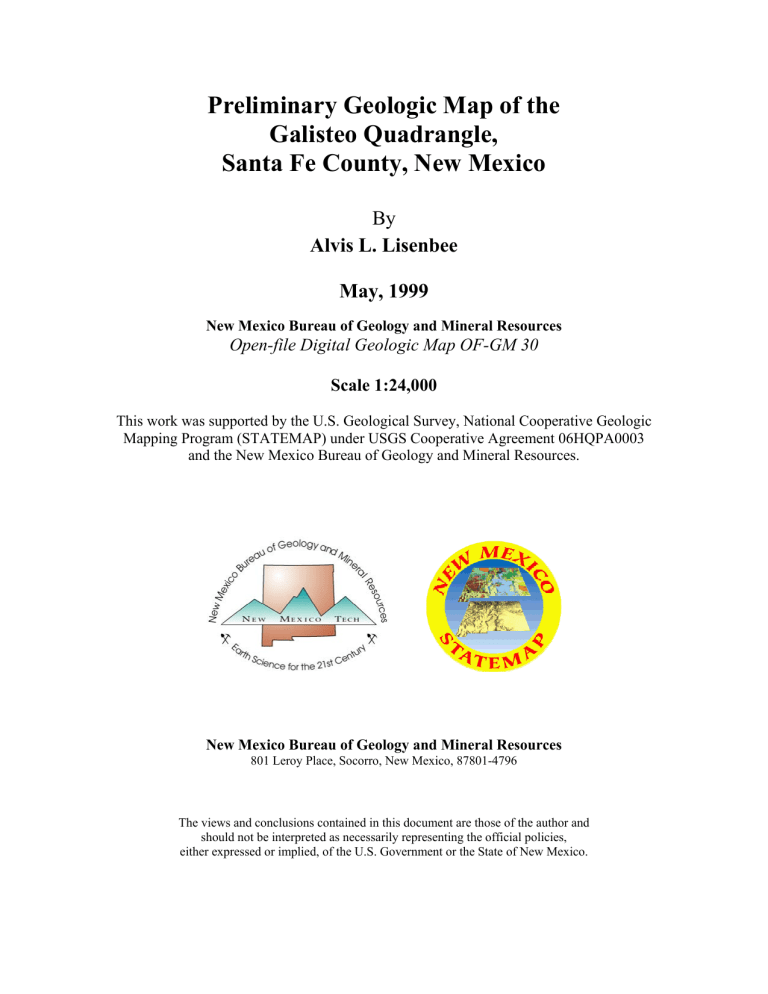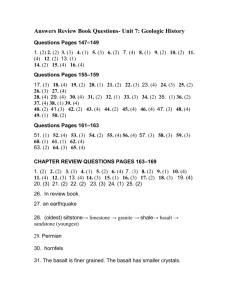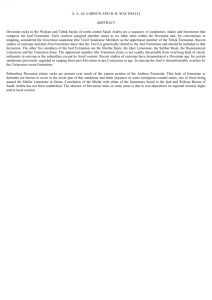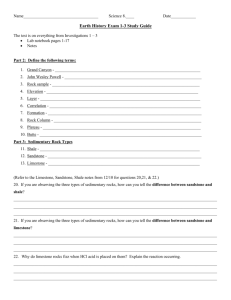Preliminary Geologic Map of the Galisteo Quadrangle, Santa Fe County, New Mexico By

Preliminary Geologic Map of the
Galisteo Quadrangle,
Santa Fe County, New Mexico
By
Alvis L. Lisenbee
May, 1999
New Mexico Bureau of Geology and Mineral Resources
Open-file Digital Geologic Map OF-GM 30
Scale 1:24,000
This work was supported by the U.S. Geological Survey, National Cooperative Geologic
Mapping Program (STATEMAP) under USGS Cooperative Agreement 06HQPA0003 and the New Mexico Bureau of Geology and Mineral Resources.
New Mexico Bureau of Geology and Mineral Resources
801 Leroy Place, Socorro, New Mexico, 87801-4796
The views and conclusions contained in this document are those of the author and should not be interpreted as necessarily representing the official policies, either expressed or implied, of the U.S. Government or the State of New Mexico.
DESCRIPTION OF MAP UNITS
IGNEOUS ROCKS (Oligocene)
Ts Sill/laccolith : Latite porphyry. Dark purplish-brown, porphyritic mixture of plagioclase, potassium feldspar, titaniferous augite, titaniferous biotite, apatite, and magnetite in a glassy groundmass. Weathers dark brown. Thickness unknown.
32.5+/-1.1 Ma (Peters, 2001).
Td Galisteo Dike : micro-monzonite: Dark gray fine grained, salt and pepper mixture of plagioclase, potassium feldspar, titan-augite, titaniferous biotite, apatite, and opaque grains in a glass groundmass. Weathers dark brown or grayish brown and stands as wall-like rampart. The dike, in map view, comprises many right echelon overlapping segments varying from 200-1200 ft in length and up to 18 ft thick. 26.55 Ma. (Erslev,
2001).
SEDIMENTARY ROCKS
QUATERNARY
Qal Alluvium: Cobbles, sand, silt, and clay transported by seasonal flooding or in active channels. Coarser clasts are dominated by quartz and granitic material.
Qca Colluvium/alluvium: Sand, silt and clay in abandoned stream channels, flood plains, and lower valley slopes.
Qls Landslide: Massive sandstone blocks of Diamond Tail Formation along steep flanks of Cerro Colorado.
Qc : Colluvium: Unconsolidated sand, silt and clay deposits along upper hill slopes or broad, flat hill crests. A few meters in maximum thickness.
Qt Terrace gravel: Rounded pebbles and cobbles of Precambrian granite, commonly containing abundant epidote, granite pegmatite, muscovite and biotite schist, and Phanerozoic chert and sandstone in a sand or silt matrix. Terraces generally lie 20 to 40 ft above valley floors.
Qp: Pediment deposits: cobble, pebble, sand and silt deposits lying upon remnants of an extensive surface cut to a former channel level of Galisteo Creek. Thickness generally less that 10 ft.
---------- u -------------
QTa Ancha Formation: Buff to moderate orange pink and grayish pink, generally poorly sorted and poorly consolidated beds of sand, gravel and cobbles. Derived from Precambrian granitic and metamorphic and Paleozoic sedimentary terrains in the
1
Sangre de Cristo Mountains. Strongly cemented by caliche near Lamy. Thickness to
18 m (60 ft).
---------- u ------------
QTac Ancha or Tesuque channel: Calcite cemented (20% to 95%) arkose or arkosic limestone overlain by medium to very coarse grained arkosic sand and red silt.
Contains numerous rod-shaped zones of caliche-cemented arkose, probably formed by precipitation from groundwater.
---------- u --------------
TERTIARY (Oligocene)
Te Espinaso Volcanics: Buff, grayish purple and reddish brown beds of agglomerate, tuff, and volcaniclastic sandstone of intermediate composition and of alluvial fan and laharic origin. Source areas are the Cerrillos Hills and Ortiz Mountains intrusive centers. Conformable with underlying Galisteo Formation. Comprises approximately
1000 ft maximum thickness in quadrangle.
TERTIARY (Late Paleocene -- Eocene)
Tg Galisteo Formation:
Tgu Upper unit : Tan to white, massively bedded, friable, well sorted, cross bedded sandstone and interbeds of red, rose, tan, and gray-green mudstone. Contains silicified logs to four ft diameter and 30 ft lengths. Thickness 346 ft in uranium drill hole #2-4 and 425 ft in drill hole 1-35.
Tgl Lower unit: Alternating pink- to red-colored beds of arkosic sandstone, siltstone, and mudstone with extensive lenses of conglomerate. The conglomerate beds contain rounded cobbles and pebbles of Precambrian granite and schist and
Paleozoic sedimentary rocks in which the relative percentage of Precambrian clasts increases upward through the section. Thickness approximately 3,500 ft.
Tdt Diamond Tail Formation Variegated sandstone, conglomerate, mudstone and local limestone beds. Sandstone beds are massive, friable, usually cross bedded and composed of medium- to coarse-grained, subrounded, poorly sorted quartz and lesser chert. Kaolin, limonite, or calcite commonly constitute the matrix. Colors are tan, brown, orange, pink, red and white. Mudstones are gray to red in color and poorly exposed. A thin, basal conglomeratic zone containing brightly colored chert is commonly present. At Lamy the section in dominantly sandstone: Stone from a quarry on the south side of Cerro Colorado was used to construct St. Michaels
Cathedral in Santa Fe. Maximum thickness approximately 1000 ft.
----------- u ----------
2
CRETACEOUS
MESAVERDE GROUP
Point Lookout Sandstone : Buff and dark brown to olive, fine- to medium- grained, massive bedded sandstone and fossiliferous brown mudstone containing calcitecemented concretions. Truncated thickness ranges from 0-60 ft beneath angular unconformity. The lower contact is gradational with the upper Mancos Shale (Satan
Tongue).
MANCOS GROUP
Kn Niobrara Formation: Comprised of upper (Kn2) and lower (Kn1) shale units and an intervening sandstone/sandy-shale (Kns). Fossils defined by Varriale
(2003).
Kn2 Upper shale member: Satan Tongue of the Mancos Shale.
Medium gray, calcareous shale; weathers olive-brown. Contains abundant concretions to three feet diameter: Gradational to the Point Lookout Sandstone.
Poorly exposed, mostly in arroyos. Contains Cordiceramus muilleri,
Crassatella pluchella, Cladoceramus undulatoplicatus . The thickness, based on cross section, is approximately 300 ft.
Kns Sandstone : Cano Tongue of Stearns (1953). Combined
Hosta-Dalton Member, Mulatto Tongue, and El Vado Sandstone of the
Mancos Shale, based upon fossil identification of Varriale (2003) .
Regression R-3 of Molenaar (1983).
Light olive-gray, even bedded, fine-grained, thin-bedded, bioturbated, ripple marked, calcareous quartz arenite and interbedded yellowish-gray siltstone.
Weathers to a low, broad, rounded ridge covered by sandstone chips.
Thickness approximately 400 ft in cross section. Placenticeras guadalupae
(Roemer), P. pseudocostatum (Johnson ); P. planum (Hyatt); Turitella aff, codellana, Gyrodes conradi, Deussinia novamexicana; Ptchodus mortoni.
Kn1 Lower shale member: Montezuma Shale Member of Mancos Shale
Medium gray, calcareous shale; weathers olive-brown. Poorly exposed, mostly in arroyos. Thickness approximately 250 ft based on cross section.
Kc Carlisle Shale: In ascending order the unit contains: The Fairport Shale Member; the Semilla Sandstone member; the Blue Hill Shale Member; the Juana Lopez member; and a thin shale member. Shale units are dark gray to black, thinly laminated, and weather to a yellow-brown color.
3
Kc shale: Approximately 50 ft of calcareous Carlisle shale lies above the Juana
Lopez Member, although the latter is the mapping top for this study.
Kcj Juana Lopez Member: (regression R-1 of Molenaar, 1983) .
Brown-gray platy, interbedded fossiliferous quartz arenite, calcarenite (commonly composed of needle-like fragments of Inoceramus shells), calcareous gray shale and gray shale. Ratio of carbonate to sand varies greatly along strike. Forms low ridges. Abundantly fossiliferous with Lopha lugubris, Prionocyclus hyatti,
Cretolamna appendiculata, Prionocyclus novimexicanus, Scaphites whitfieldi, and Inoceramus perplexus. The later three fossils indicate an early Late Turonian age. Thickness ~65 ft.
Kcb Blue Hill Member:
Dark-gray shale. Three zones of septarian concretions (3 ft) weather to rubble:
Enclosing shale rarely exposed. Thickness ~ 160 ft . Fossils include Ptychodus whipplei and Cretolamna appendiculata.
Kcs Semilla Sandstone Member :
Fine- to very fine-grained, thin bedded, bedding-parallel, bioturbated quartz arenite and interbedded shale. Three to 10 ft thick. Generally poorly exposed.
Contains abundant fossils including Prionocyclus hyatti, Carota dalli , and Pinna
Kaufmani .
Kcf Fairport Shale Member
Calcareous shale, bentonite, and minor limestone with concretions. Not exposed in quadrangle but approximately 188 ft thick in Ojo Hedionda Quadrangle to south.
Kg Greenhorn Limestone: Bridgeport Limestone Member
Alternating beds of dark-gray, argillaceous micrite and medium- to dark-gray calcareous shale. Most beds are less than 1.5 ft thick. Weathers light-gray and forms a low ridge. Imprints of Inoceramus labiatus are common as are foraminifera.
Thickness is approximately 50 ft.
The Dakota Sandstone and Graneros Shale are intertonguing units. The Dakota
Sandstone is divisible into three sandstone tongues (Two Wells, Paguate, and the combined Cubrero, Oak Canyon, and Romeroville) separated by the Whitewater
Arroyo and Clay Mesa members (Lucas et al., 1998; Lucas, 2000).
Kgr Graneros Shale--Lincoln and Hartland Members ? Tan, gray, and black, calcareous shale and thin lenses of fine-grained, calcareously cemented, tan and brown sandstone. Alternations of gray and brown shale and sandstone give outcrops in arroyos banded appearance. Thickness 66 ft at Lamy.
4
Kdtw Dakota Sandstone--Twowells Member
Tan quartz arenite, medium to course-grained with quartz and chert. Shell fragments and vertical burrows. Medium to thick bedded, some with cross beds.
Twenty four feet thick at Lamy. Absent in southern portion of quadrangle.
Kgrw Graneros Shale--Whitewater Arroyo Shale Member:
Tan, gray, and black, calcareous shale and thin lenses of fine-grained, calcareously cemented, tan and brown sandstone. Weathers to grass-covered prairie. Thickness 40 to 80 ft in Lamy area and 108 ft in southeast corner of quadrangle where the Two Wells is absent..
Kdp Paguate Sandstone Member:
Buff to khakhi, bioturbated, fine to medium grained, thin bedded quartz arenite with three or less bentonite beds. Alternations of gray and brown shale and sandstone give outcrops in arroyos banded appearance. Fossils include
Acanthoceras amphibolum, Tarrantoceras sellardsi, Turrilites acutus americanus, Aphrodina cf. A. munda (Stephenson), Ostrea beloiti (Logan) and
Inoceramus rutherfordi (Warren). Forms low questa. Thickness 17 to 40 feet in the Lamy area and 23 feet in the southeast. Transitional lower contact with Clay
Mesa Shale Member.
Kgr Clay Mesa Shale Member:
Light gray and black, silty shale, limestone, quartz arenite lenses, numerous bentonite layers, and large limestone (to 3 ft) and cone-in-cone concretions. A zone of calcareous concretions to 12 ft diameter is present in the basal portion.
Weathers to grass-covered prairie. Abundant fossils include Acanthoceras amphibolum (Morrow), Tarrantoceras sellardsi (Adkins), Cretoxyrhina Mantelli
(Agassiz), Cretodus Semiplicatus (Munster), Squalicoras curvatus, Squalicoras falcatus (Agassiz) and Ptychodus occidentalis (Leidy).
Thickness 83 ft at Lamy
(Lucas, 2002) and Hub Canyon in Ojo Hedionda Quadrangle. undivided:
In southeastern portion of quadrangle lower and upper, tan to orange-brown, fine- to medium-grained, medium- to thick-bedded, bioturbated, including scolithus, quartz arenite: middle portion consists of sandstone and variegated siltstone or, locally, gray shale and highly carbonaceous black shale interbedded with thin lenses of tan sandstone, commonly containing fragments of coal: thickness approximately 49 ft in southeast. In Lamy area thickness varies from 1 to 20 ft of thin-bedded, fine-grained, bioturbated quartz arenite.
--------------- u -------------------------
JURASSIC
Jm Morrison Formation: Upper portion of the section is white, kaolin-bearing sandstone (Jackpile) underlain by green, gray and maroon mudstone, interbedded tan
5
and light red-brown sandstone, and lenses of tan and white pebble conglomerate.
Sandstone is fine grained, subangular to subrounded quartz and minor chert and feldspar. Bedding is platy to massive and cross beds are common. Thickness undetermined.
SAN RAPHAEL GROUP
Jt Todilto Formation: Light grayish-brown limestone: laminated and crenulated with fetid odor on fresh surface. Overlain by thin bedded, dark-gray limestone containing red jasper nodules. Thickness 40-50 ft (Booth 1977).
Je Entrada Formation: Rose, buff, and white, cross-bedded, quartz arenite.
Extremely friable. Thickness approximately 100 ft in Ojo Hedionda quadrangle to south.
Only the upper few feet are exposed in quadrangle.
TRIASSIC
CHINLE GROUP
Tr Triassic undifferentiated: Red-orange, dark brown, purplish gray and green, thick bedded mudstone, buff to dark red brown, cross bedded sandstone and limestone pebble conglomerate. Incomplete section exposed along western margin of Glorieta Mesa.
Thickness in subsurface approximately 1850 ft.
The following units are not exposed in the quadrangle, but are shown on cross sections. Thicknesses are taken from log of the Trans-Ocean, McKee #1 well and from Booth (1977) for the area north of Lamy. Descriptions of the unit are from
Booth (1977) and Bachman (1979). Some units combined in cross sections.
PERMIAN
Pb Bernal Formation : Yellowish gray to reddish purple sandstone and siltstone and brown limestone pebble conglomerate. Fifty 50 to 110 ft thick.
Psa San Andres Limestone : Medium to light gray, fine grained, fetid limestone and interbedded calcareous sandstone. Six to 40 ft thick.
Pg Glorieta Sandstone: Medium to light gray, medium to fine grained, well sorted sandstone. Twenty to 65 to 110 ft thick.
Py Yeso Formation: Medium reddish brown to red mudstone, siltstone, fine grained sandstone and pale greenish purple limestone. Twenty one to 70 to 140 ft thick.
Psc Sangre de Cristo Formation : Medium brown to dark reddish brown mudstone and buff to dark brown, conglomeratic arkose. Ninety one to 300 to 3,000 ft thick in the Canoncito area northeast of Lamy along Tijeras-Canoncito fault zone.
6
PENNSYLVANIAN
IPm Madera Formation: Gray to light brown, thick bedded limestone, gray to brown calcareous sandstone and buff and dark brown fossiliferous arkose. Thickness 820 ft.
Ms Sandia Formation : Buff to brown sandstone, interbedded gray shale and argillaceous limestone. Thickness 160 ft.
Mt Terrero Formation: Buff to dark brown, thick bedded, coarse grained limestone breccia in calcareous arkose matrix. Thickness 30 ft.
PRECAMBRIAN BASEMENT: Proterozoic granite and mica schist .
SELECTED REFERENCES
Anderson, O. J., Lucas, S.G., Kottlowski, F. E., Bauer, P. W., Love, D. W., Hawley, J.
W., G. S., Smith, Pazzaglia, F. J., and Cross, A., 1995, Stratigraphic Nomenclature Chart, in Geology of the Santa Fe Region, New Mexico Geological Society, Bauer, P. W.,
Kues, B. S., Dunbar,D. W., Karlstrom, K. E., and Harrison, B., Editors , Forty-sixth
Annual Field Conference.
Bachman, G. O., 1975, Geologic map of the Madrid quadrangle, Santa Fe and Sandoval
Counties, New Mexico: U. S. Geological Survey, Geologic Quadrangle Map GQ-1268, scale 1:62,500.
Booth, F. O., III, 1977, Geologic Map of the Galisteo Creek area, Lamy to Canoncito,
Santa Fe County, New Mexico: U.S. Geological Survey Map MF-823.
Erslev, E. A., 2001, Multistage, multidirectional Tertiary shortening and compression in northcentral New Mexico: Geological Society of America Bulletin, v. 113, p. 63-74.
Kautz, P. F., Ingersoll, R. V., Baldridge, W. S., Damon, P. E., and Shafiqullah, M., 1981,
Geology of the Espinaso Formation (Oligocene), north central New Mexico: Summary:
Geological Society of America Bulletin, v. 92, p. 980-983.
Lucas, S. G., Cather, S. M., Abbott, J.C., and Williamson, T. E., 1997, Stratigraphy and tectonic implications of Paleogene strata in the Laramide Galisteo Basin, north central new Mexico: New Mexico Geology, p. 89-95.
Molenaar, C. M., 1983, Major depositional cycles and regional correlations of Upper Cretaceous rocks, southern Colorado Plateau and adjacent areas: in
Molenaar, C. M., Cobban, W. A., Merewether, E. A., Pillmore, C. L., Wolfe, D. G., and
Holbrook, J. M., 2002, Regional stratigraphic cross sections of Cretaceous rocks from east-central Arizona to the Oklahoma Panhandle: U. S. Geological Survey,
Miscellaneous Field Studies, MF-2382.
Peters, L., 2001,
40
Ar/
39
Ar Geochronology results from Galisteo Quadrangle dacite: New Mexico
Bureau of Geology and Natural Resources: Internal Report # NMGRL-IR-84, 8 p.
7
Rankin, C. H., 1944, Stratigraphy of the Colorado Group, Upper Cretaceous, in Northern New
Mexico: New Mexico Bureau of Mines and Mineral Resources Bulletin, v. 20, 26 p
.
Stearns, C. E., 1953, Upper Cretaceous rocks of Galisteo-Tonque area, North-central, New
Mexico: Bulletin of the American Association of Petroleum Geologists: v. 37, p. 961-
974.
Varriale, F. J., 2003, Ammonite biostratigraphy of the Cretaceous System (Middle Cenomanian to Lower Santonian), Galisteo, New Mexico: M.S. thesis, South Dakota School of Mines and Technology, 179 p.
8








